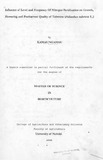Influence of Level and Frequency Of Nitrogen Fertilization on Growth, Flowering and Postharvest Quality of Tuberose (Polianthes tuberosa L)
Abstract
This study was conducted to determine the influence
of various levels of Nitrogen and frequency of application
on growth, flowering and postharvest quality of tuberose.
Nitrogen tended to stimulate an increase of leaf
length in Kabete but did not influence the number of basal
leaves. with the application of 0, 21.25, 42.5 and 85.0 kg
N/ha, leaf length increased from 38.2 cm to 39.2, 40.5 and
38.2 cm . However increase this was not significant.
Nitrogen application promoted the increase of the
spike and rachis length and spike diameter both at Kiambu
and Kabete. However, only the spike diameter increased
significantly with application of N giving the highest
spike diameter at the highest N level. Split N application
also positively promoted greater spike and rachis length
and spike diameter. The spike growth rate and the number of
leaves and florets per spike were not significantly
influenced by N level. The distal floret size and colour
were not significantly affected by N level. However, the
latter decreased while the former tended to increase with
N levels.
Increased N levels delayed the senescence of flower
sepals and the yellowing and senescence of distal florets
but it did not prevent their abortion. The application of
0, 21.25, 42.5 and 85.0 kg N/ha significantly delayed
senescence of sepals and the unopen distal florets giving
the greatest delay at the highest N level. Split
application of N did not significantly influence the
period to senescence of sepals and the yellowing and
senescence of the distal florets. However, the period to
the wilting and senescence of the last open floret and the
total number of open florets tended to decrease with split
N application. Nitrogen application did not significantly
influence the period to the wilting and senescence of the
last open floret and the number of dry and senesced
florets.
Both split N application and the levels of N
increased the number of spikes produced. However, the
increase due to N levels was not statistically
significant. The spike yield increased with split N
application and rose from 17.5 to 18.0 and 23.8 sterns per
plot (m2) at 4 wk, 2 wk and 1 wk application interval,
respectively.
Nitrogen application increased production and quality
of cut tuberose. A level of 42.5 kg N/ha application
promoted optimum response for most observed parameters.
Split N application was also found to improve yield and
quality of cut tuberose with higher frequencies of
application giving better results.
Citation
Master of Science in HorticulturePublisher
University of Nairobi Faculty of Agriculture. University of Nairobi

